Back to Trip Reports
Title: India 2009
Trip Type: Specialist Photo trip organised by Photographers on Safari and the whole itinerary was arranged by Wildlife Trails using their Indian agent Perfect Travels. 2 weeks.
Outline Itinerary: Delhi, Bandhavgarh NP, Agra (Taj Mahal), Ranthambore NP, Delhi. Ground travel within India mainly by train with some road travel too.
When: February
Equipment: Nikon D200/MD-200, D300/MD-10, Nikkors 70-200/2.8, 200-400/4, 18-70/3.5-45, TC-14E, Wimberley WH-200, Gitzo GT3540XLS, SB-800 + laptop, readers, duplicate ext. hard drives, etc.
Photographic Highs and Lows:
I am not sure there were any real photographic low points on this trip. If I was being critical it would been really useful to have a wider lens for the Taj Mahal, for some of the shots I was hard against the widest setting on my standard zoom which was often not really enough. I now have a Nikkor 12‑24mm which would have seen a lot of use but sadly I did not have it at the time, and I am not sure that I would have taken it anyway. But I would if going again!
|
|
The challenge of not being able to get far enough back or reduce the focal length further led to some tight crops and one or two converging verticals from tilting the lens back. I am sure some of the latest software would probably be able to be put to work effectively correcting the latter issues but that is not really my thing (although I have had a little play in my old, rarely used version of Photoshop with some positive results but distortions are still obvious), perhaps something for the future……..but probably not :-)
|
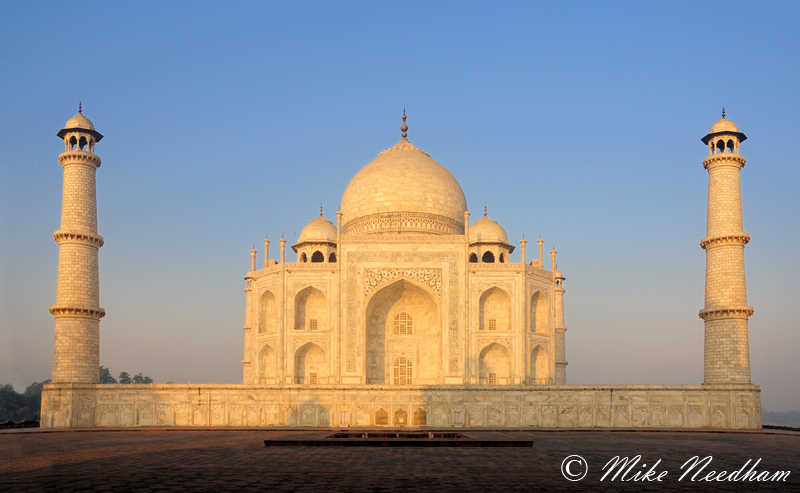 ......and following my crude attempts to correct them (and carefully cloning out a few fellow visitors), better but not brilliant ......and following my crude attempts to correct them (and carefully cloning out a few fellow visitors), better but not brilliant |
We actually arrived at the Taj before sunrise and I would really recommend doing so if you can have the flexibility in your schedule. Whilst queuing for the doors to open the streets were very atmospheric and with a moderately fast lens and high ISO there were some interesting pictures to be had. Again, not really my thing but a good way to pass the time. The palace itself was also less busy immediately after opening, though it was hardly empty.
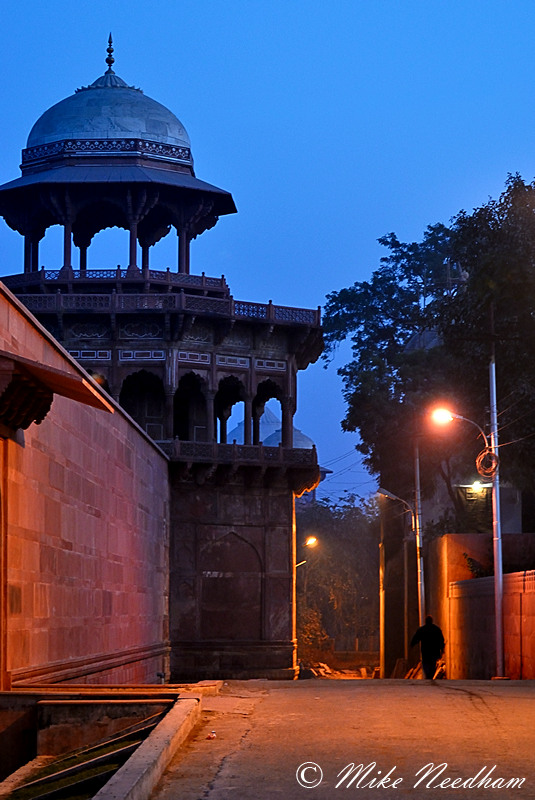
This image was actually taken whilst standingin the queue waiting for the Taj Mahal to open |
The advice we had been given was to hire a guide once we were inside the grounds if we wanted to maximize our image productivity during the brief period of golden light. The guides charge around $20-30 (US) and mine was certainly worth every cent. I didn’t get many shots that I could not have seen and captured on my own, but I certainly would not have got them all in a single short visit and certainly not in the beautiful but brief morning light. It was a real frantic hour or two (it was so frantic I really could not estimate the period over which I took my shots without referring to the EXIF data), the guide would say “stand here on this stone, crouch a little and look through that arch”. You would then see a delightfully framed shot which could be tailored through focal length selection, exposure and slight positional shifts, to get an image you wanted. I would take a few frames and then we would literally run to the next position so as to make the most of the best light. This is certainly not something I would do regularly, or for wildlife, but many of the vantage points would have each taken several hours to find. For a brief one off trip such as this however it was actually quite good fun and, I did not shoot every scene offered, and I added some of my own. You have to use such opportunities to get the images you want, not just shoot as if YOU are in program mode. Once we had finished I then had plenty of time to wonder around on my own to photograph architectural details and people. All together a wonderful experience which far surpassed my expectations (if I had been building my own itinerary I would not have gone, but I was glad that I did). |
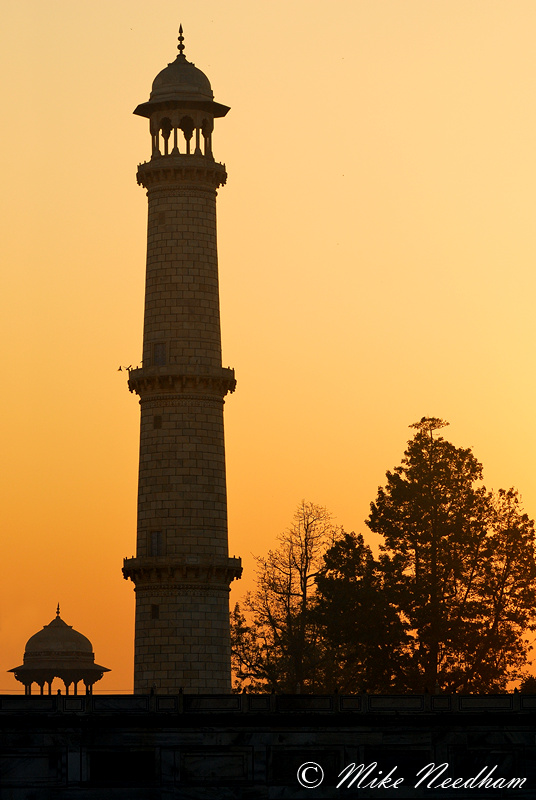
There are lots of details (and people) to capture inaddition to the palace itself, 2-3 hours is nowhere near long enough |
|
The detail and scale is truly amazing |
A classic shot at first light, I literally ran in to the grounds with my guide to get a few shots without crowds of people |
There are some lovely 'framing' opportunities but to find them all whilst the light is still good on a first visit would be impossible |
The Taj Mahal was actually in the middle of the trip, the first destination was Bandhavgarh NP (Nature Heritage Jungle Resort) which was the core of the tiger trip. I, like most people, have seen many of the wonderful wildlife films about tigers in India where the impression is given that there is one behind every bush. When I booked this trip I put these ideas very much at the back of my mind and managed my own expectations very strongly. In this particular year John (Photographers on Safari) had decided for the first time to offer an extension to Ranthambore NP, a very famous tiger reserve. I have to confess my only reason for booking this addition to the trip was to give myself ‘two bites at the cherry’, I was settled in my own mind that if I could get just a handful of good tiger shots, one even, I would consider the trip to be a success. It was with this firmly in my mind that I entered Bandhavgarh for the first time.
|
Bandhavgarth NP shot from the highest point in the park, Banhavgarth Hill (811m) |
The first drive was no more than 10 mins in when we spotted our first tiger, a moving outline in the dense bushes which we followed for a few minutes before it raced out across the track in front of us. I got just a single frame, the only one to do so I believe, but psychologically this was a huge boost. Later that afternoon we got clear views of a rather distant male marking his territory in the fading light. My ISO was struggling in the low light but we were off to a reasonable start.
|
My first ever fleeting glimpse of a wild tiger |
Subsequent days in the park each produced excellent encounters of various types and where the tigers were too far from the track to be readily seen the mahouts would bring up the elephants (only in the mornings) so that everyone had the opportunity to get closer via an ad-hoc rota system. One particular morning we turned up to a situation where the resident male was courting a female whilst a challenger was shadowing them. The cats were away from the track and the elephant treks to see them had already begun when I arrived. When my turn on the elephant came we head off and could soon hear the male and female off to the left in some dense undergrowth. The mahout however pointed right and headed away from the vocalizations. As we rounded a corner, there 15-20m directly in front of us was the other male sat up on a rock formation. He was at eye level to us and paid little attention as we approached, cameras shooting. I viewed most of this through the viewfinder, the constant movement of the elephant and direction changes from to mahout so everyone can get a view, meant you had to take shots as and when they briefly presented themselves. Then horror! The zoom on my lens had stuck and I could not ‘zoom out’ to compensate for the closing distance, I lowered the camera from my eye and there, no more than 2m in front of me and at roughly the same level was a huge male tiger laid contently surveying the scene in the direction of the courting pair. My zoom had not stuck, a 70-200mm was simply much too long for the distance. I never felt in danger but it was a magical movement to be so close to such a powerful beast and to have only air between us.
|
The tourists were gone and it was time for a well deserved drink |
The best 4x4 in the forest bar none! |
Only a few metres away from a wild male tiger from elephant back |
We also had a good number of encounters whilst in the jeeps and including one occasion where we had come across what we believed to be a mother and two adolescent male ‘cubs’ about 18 months old. They were somewhat obscured by the undergrowth but presented the odd opportunity. One of the youngsters started to head for the track as if he was planning to cross; his mother was on the other side. There was a smaller clearing in one of the bushes which, suspecting he would pass through it, I framed up and focused on. Sure enough I could see him coming into view in the viewfinder when suddenly there was noise from another vehicle. He veered off and laid down. My shot was ruined and I was not happy about it! This is the other side of wildlife photography in popular parks and reserves, some people don’t seem to understand or respect nature and treat them like any other tourist attraction. I still got a few shots but none where a match for what might have been.
 - Bandhavgarh India February 2009_336.jpg) |
Quite surreally as we sat a while with the tigers one of the forest guards cycled up the track towards us, clearly en-route somewhere in the golden late afternoon sunlight as if casually cycling down his home street. Seeing the gathering of vehicles which had amassed by now, and subsequently conversing with some of the guides, he clearly got the message that there were tigers around and it would be prudent not to continue. He calmly waited until he could leave along side of one of the vehicles, clearly this was not an unusual situation for him.
Two tigers in the undergrowth watching on as one of the forest guards cycled obliviously down the track
A lovely day for a bicycle ride? |
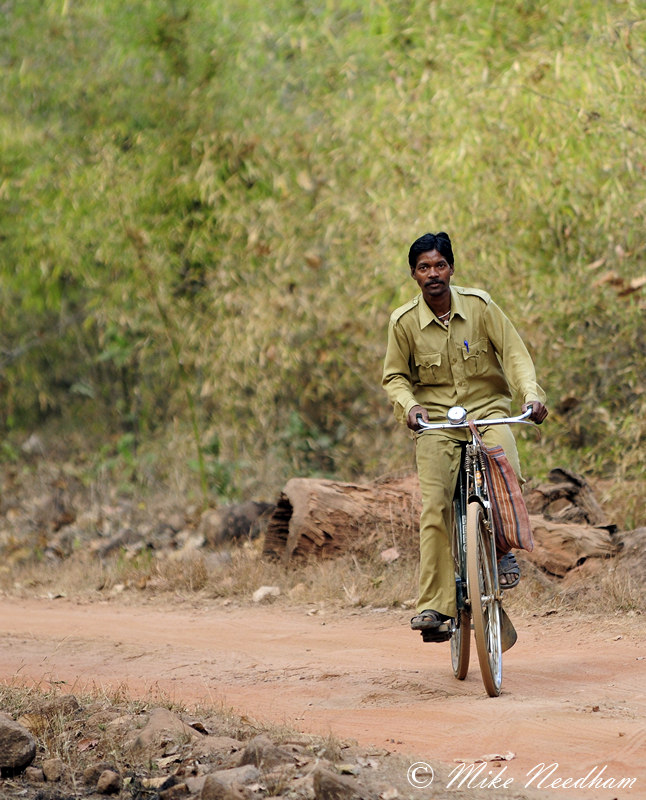 |
Some of the supporting cast from Badhavgarth
|
Hanuman Langur |
Plum-headed Parakeet |
Sambar Deer |
The week at Bandhavgarh was more productive than I had ever dared dream and the last morning meant my stay would finish with another great memory. The morning had been relatively uneventful, it was late and we were a few hundred meters from the exit when the guide asked if we would like one last trek on the elephants. There could only be one answer, elephant treks meant tigers and the expression of the guide’s face suggested it was not something to be missed! The park was empty, it was already closing time, but there by the river was an elephant waiting for us. We were quickly on board and then to my surprise we headed off into the river. Surely there couldn’t be a tiger in the river at this time of year, it must just be the quickest route to it? Wrong! There was indeed a tiger in the river and she was wading across. We had a couple of brief minutes with her and then she was gone, we could not follow as the park was closed, but I returned to the lodge on a real high but sad to be leaving Bandhavgarh in the next hour or two. It was a truly amazing place to see tigers, helped to no small degree by our superb guides (thanks John!).
|
This was not typical of the encounters we had in Bandhavgarth but the tigers were rarely lacking admirers when cvlose to a track |
The last minutes of the last drive in Bandhavgarth were the highlight |
From Bandhavgarh NP we travelled by train to Agra and the Taj Mahal, and then on to Ranthambore NP (Ranthambore Regency) for (hopefully) more tiger action. Ranthambore was an interesting contrast to Bandhavgarh, still a grassland and densely wooded region but much more arid. The contrast was nice as there was a clear differential in the pictures from the two regions. The way that the parks were run was also quite different. There were some rules about routes and having to go via a checkpoint in Bandhavgarh (I have to confess that they were not particularly clear to me even at the time, nor did they have much impact on our game viewing) but in Ranthambore there was a strict zonal system to limit the number of vehicles in any one part of the park and around any sightings.
|
Beautiful Ranthambore NP with the fortress on the distant hill top |
In theory this sounds like a good idea, your zone is allocated via a lottery just before the gates open, and you certainly don’t then see huge numbers of other tourists during your drive. However, the tiger population is not evenly distributed and the habit varies considerably from open ‘bush’ / grassland to dense woodland where viewing is far more challenging. I seem to remember there were 5 zones, and it could be very frustrating if you could see another vehicle in an adjacent zone in the distance with a sighting not to be able to drive over to it. We also quickly realised that some zones were much more productive than others. Draw zone 4 and everyone knew that you were almost certain to get a sighting, and it was usually a very good one. However, draw zone 1 and you may as well look for birds or monkeys to photograph, I don’t believe anyone saw a tiger in zone 1 whilst I was there.
|
A treepie, the highlight of Zone 1! |
The relative productivity of the various zones may well vary from visit to visit so don’t take these comments as absolutes should you visit, the reason that I mention it is to make the point that if you plan to go to Ranthambore (and I hear that Bandhavgarh too has now introduced some type of zonal system) there are certain things out of your control and to maximize the likely hood of getting some good sightings, and therefore pictures, you should plan to visit for at least 3 full days. That said I got tiger shots every day in both parks (not every drive, especially in Ranthambore) but spoke to someone in the hotel at Ranthambore who had been there 4 days and seen nothing. It is partly down to luck and, in my opinion, the quality of your guide. I would sooner have 4 days with a great guide then 6 or 8 days with a poor one. Getting a good guide can be luck, but some people like John at Photographers on Safari do a lot of work to minimize this and so stack the dice in your favor :-)
At the time my impression of Ranthambore was very positive, despite the zonal system, but I thought it fell well short of the opportunities I had had at Bandhavgarh. I was therefore a little surprised on my return to find that in terms of the number of quality photographs taken the two parks were very similar and if I had to make the call I would say that Ranthambore had produced slightly more ‘quality’ shots than Bandhavgarh. That said, if I were to go back Bandhavgarh would probably be the first on my list.
Some of the tigers of Ranthanbore....
 - Ranthambore India February 2009_128.jpg) |
%20-%20Ranthambore%20India%20February%202009_021.jpg) |
%20-%20Ranthambore%20India%20February%202009_098.jpg) |
As with Bandhavgarh, I have some cherished photographic memories from Ranthambore. One morning we came across two juvenile male tigers about 18 months old. We tracked with them for quite some time and got some reasonable shots until we ended up on a raise bank that looked like a small dried out dam. It was probably about 15-20 feet high and just wide enough for a jeep to comfortably drive along the top. The ‘boys’ had been walking towards this feature and our guide had clearly anticipated that they may well walk along it and so had gotten us in position ahead of them. Sure enough they made their way towards us, climbed up the far banking and started to play a little when one of them had had enough and laid in the grass. His brother, still full of energy, decided that perhaps our jeep may be more fun and trotted over towards us. Our driver quickly backed us out but had to be careful due to the drop at either side, thus allowing the youngster to trot after us just a few feet in front of our jeep’s bonnet. Juvenile he may have been, but an 18 month male tiger is a big cat to be running towards you when you are in a totally open small jeep and are first in line! That said I never felt threatened by this.
%20-%20Ranthambore%20India%20February%202009_201.jpg) |
The young tiger soon tired of this game and settled down in some grass so we stopped. It was at this point that we noticed their mother, who we had not seen for a little while, on the other side of us walking up a bank. This mean that she was very slightly higher than we were in the jeep and so the pictures of her looked as if I was laid in the grass shooting her has she passed by. She was clearly not a fan of this ‘paparazzi’ attention and turned to snarl at us before disappearing into the undergrowth. It was all over in an instant but there was just enough time to get one frame of the snarl which was good enough for me. Too close for comfort as his brother looks on in the background, shot at 75mm! "The Snarl" by mum |
%20-%20Ranthambore%20India%20February%202009_247.jpg) |
Both Bandhavgarh and Ranthambore have more to offer than just tigers, there are hanuman langurs, macaques, lots of different birds, various species of deer, jungle cat, etc. If your are really lucky there are also bears (unlikely this time of year but apparently not uncommon in warmer months) and dhole (a type of wild dog, not seen on this trip).
And some of Ranthambore's supporting cast.....
|
Sambar Deer |
Young Rhesus Macaque |
Male Pea Fowl |
Whilst at Ranthambore we also visited a small local village (this was prearranged but not a ‘tourist’ village) to do a little cultural photography and we scoured the crop fields looking for blackbuck antelope. These antelope have lost most of their natural habitat and so have turned to a life subsisting on human arable land. This has brought them into conflict with locals but they are now legally protected, however whilst the locals no longer openly kill them they do still drive them away at every opportunity and so the antelope are incredibly wary of people. Getting close, even in a vehicle, is therefore incredibly difficult and only distant shots were possible. I found this to be the same on a later attempt to photograph them in another region in 2011, only the higher crops on the second occasion gave me some cover to approach on foot, but I was still neither close or tolerated.
Real village life, it was a real privaledge to see local life and to be welcomed into their community......
.jpg) |
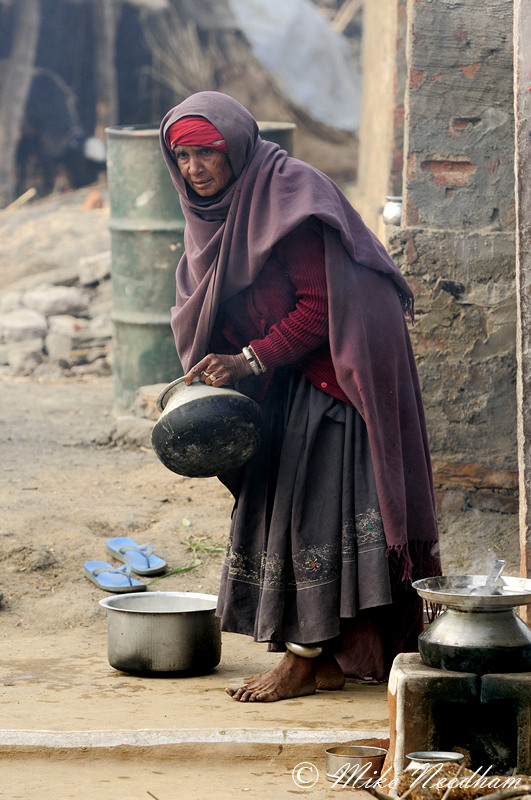 |
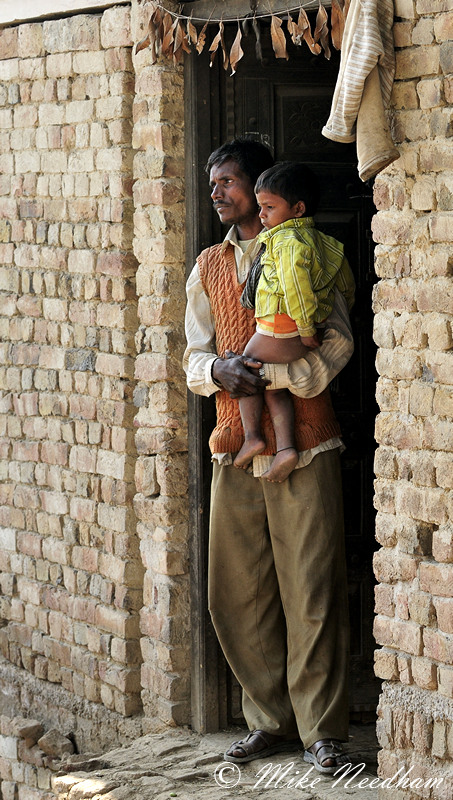 |
Photographically the trip totally exceeded my expectations and it was a real privilege to see these magnificent animals living in the wild. As with Africa too, it is also very humbling to see how the locals accept and live along side these top predators, especially coming from a country that has for centuries been made devoid of anything more harmful than a red fox! I also enjoyed the people photography which was something totally new to me, I even enjoyed the visit to the Taj Mahal.
Other Comments:
One non-photographic aspect of this trip worthy of mention was the ground travel, and specifically that done by rail. Looking at a map of India can be somewhat deceptive, make no mistake it is a huge country. Delhi to Bandhavgargh took about 14 hours by train and what better way to cover such distances then to travel by sleeper overnight. Most of the ground travel was by train and I found it to be a comfortable and relaxing way to cover the distances, especially in a group. I would be less comfortable travelling alone purely from a security point of view, specifically the security of my belongings not myself. In terms of personal security it felt no less safe than the railways in the UK. Leaving any belongings unguarded however was definitely to be avoided, and despite lots of precautions one of our party had his wallet and passport stolen, we believe the day before he discovered them missing. So, to have to leave luggage whilst using the ‘facilities’ would be a major concern if travelling alone.
The travel on this trip was a mixture of 1stand 2ndclass ticketing, apparently getting 1stclass tickets is not easy and cannot be guaranteed. Both were comfortable and converted into bunk beds for overnight travel and other long journeys. The only major advantage of 1stclass was that the accommodation was in the form of four bunk compartments with a lockable door, as opposed to curtain screening. The 1stclass accommodation did bring its own dramas however.
On one of the journeys, I don’t remember which, the group was split between several compartments and regions of the train. I and a fellow group member were in a 1stclass compartment which we shared with an Indian family. We had all settled in and were exchanging polite conversation when there was a knock at the door. It was the train steward (or similar). He checked everyone’s tickets and then started explaining something in Hindi and gesturing for us to leave the carriage. Certain that I was in the correct carriage I stayed seated as if I did not understand (I clearly did not understand the conversation side of things). At this point the father of the family we had been chatting to kindly explained that an ex. local state governor and his family had turned up without tickets and we were being moved out to accommodate them. I could sense myself running over whether to cause a fuss or go with the flow when he went on to say that my travelling companion and I were being moved next door (were other members of our group were accommodated) whilst he and his family were moving to 2ndclass (I assumed because there were four of them and not there was not sufficient space for them to stay together in 1st). I thanked him and move myself and my luggage next door as the new arrivals were moving in without a glimmer of apology or embarrassment. When I was resettled back down and thought about what had just happened I was really taken aback how accepting this family was of being moved out of 1stto 2ndbecause someone had turned up without booking, whoever they may happen to be. Certainly I would not be so understanding if I was back home and something similar occurred. At this point I also thought a little more about why we had moved next door and yet the family had been shifted to 2ndclass. I had assumed in the heat of the moment that it was a space issue but on further reflection I realised that whilst there were four of them (mum, dad and two small children) they still were originally only occupying two bunks in 1st. Perhaps it was because we had companions next door, but if that was the case and those bunks were available why were we not in there from the start? With everything else going on and it being time to sleep we did not discuss this further as a group, but I now suspect that the steward had also moved people out of next door to make space for my travelling companion and I. If this was the case it makes me very uncomfortable and if I had fully appreciated at the time what was going on I would have offered the family the option of 1st. It was a strange carry-on and all over in 2-3 minutes but a stark reminder of the cultural differences between our two countries.
Back to Trip Repots or General Ramblings

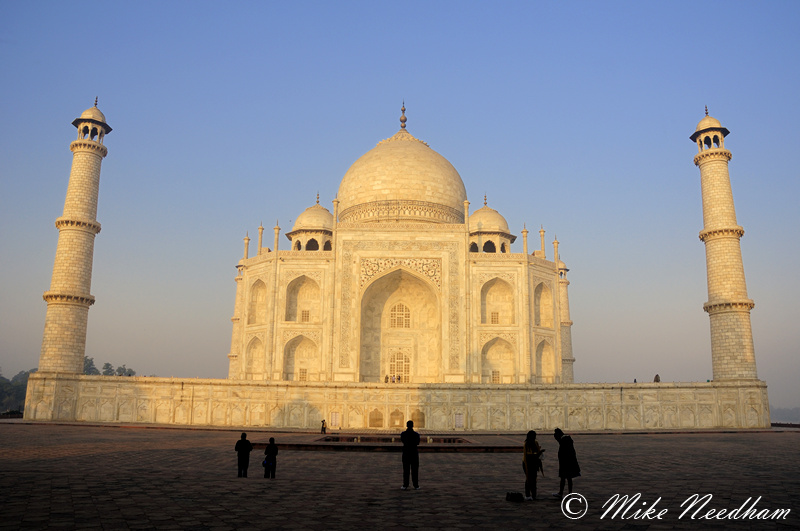
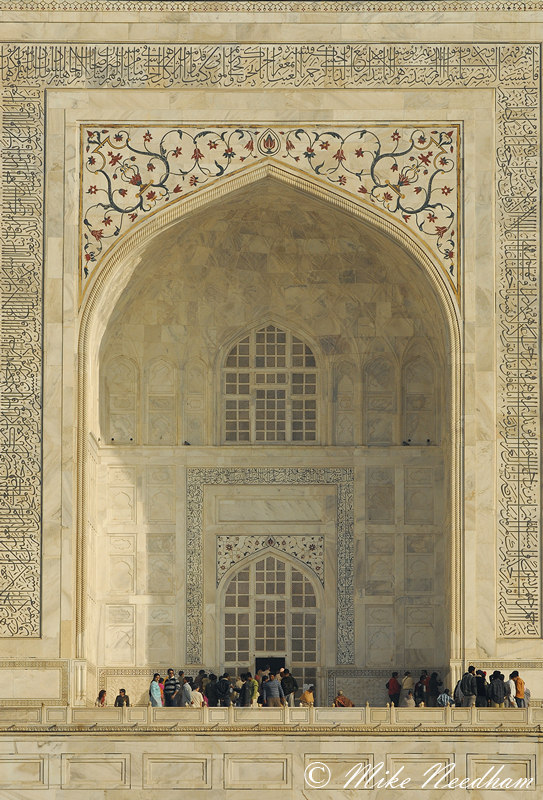
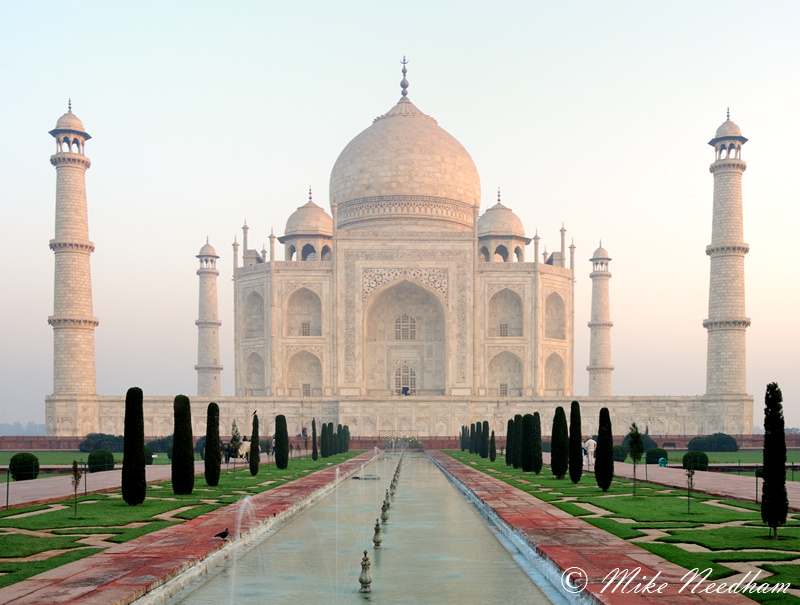
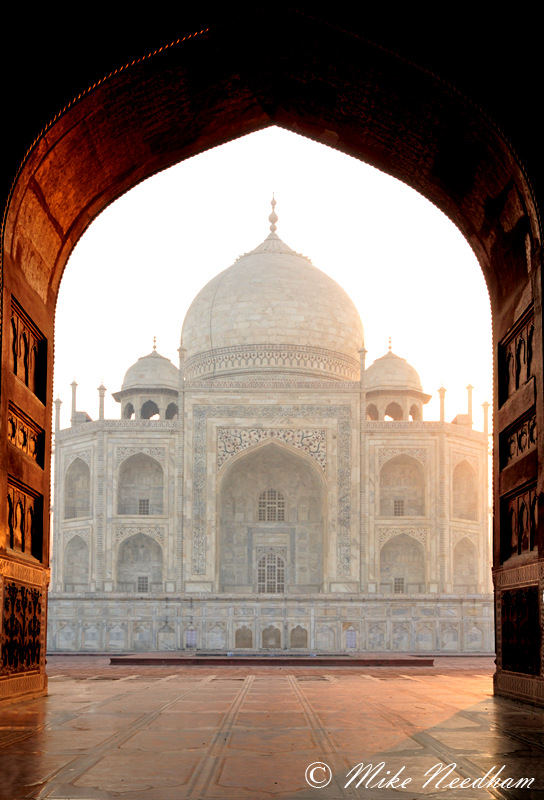
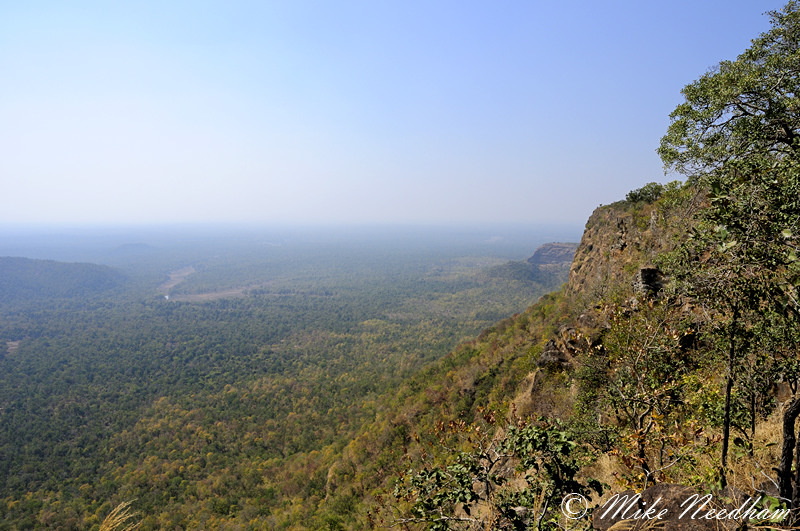
 - Bandhavgarh India February 2009_001.jpg)
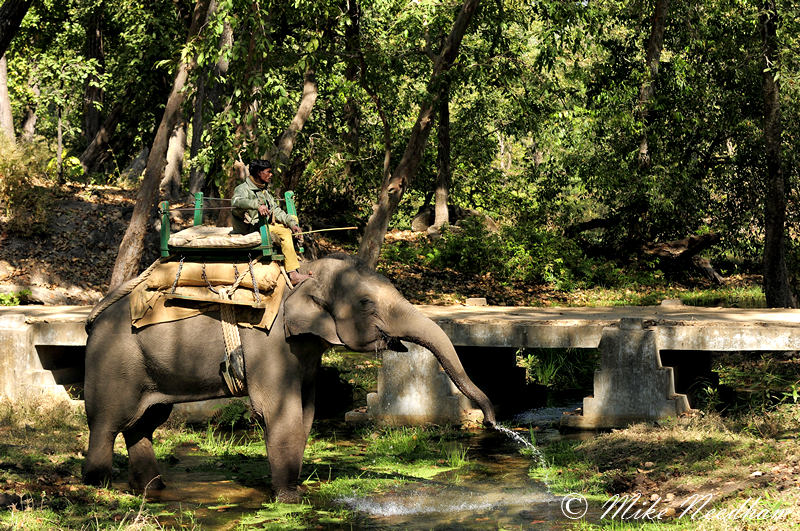
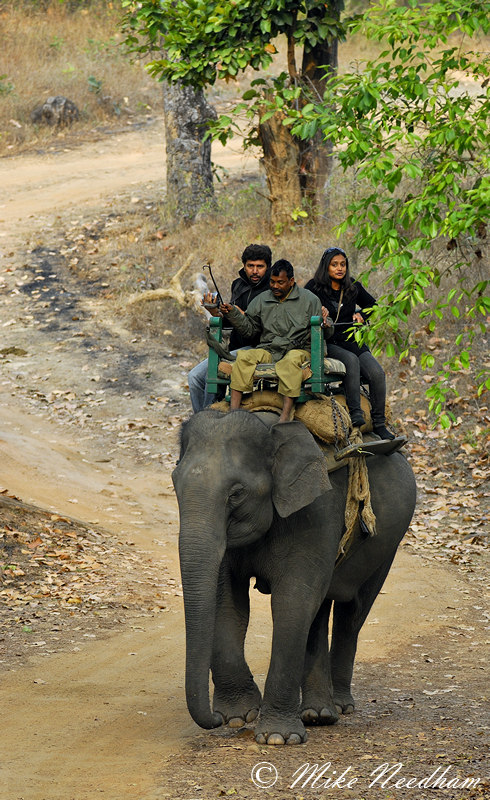
 - Bandhavgarh India February 2009_206.jpg)
%20India%20February%202009_031.jpg)
%20India%20February%202009_024.jpg)
%20India%20February%202009_025.jpg)
%20-%20Bandhavgarh%20India%20February%202009_197.jpg)
%20-%20Bandhavgarh%20India%20February%202009_348.jpg)
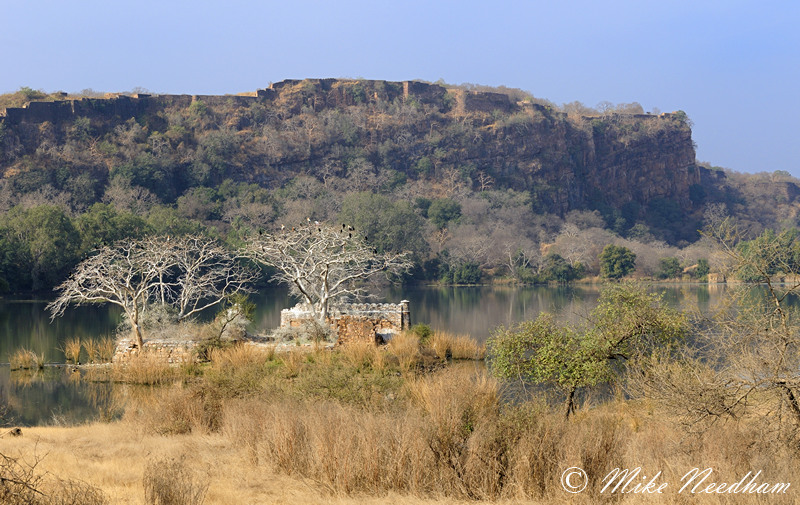
%20India%20February%202009_019.jpg)
%20India%20February%202009_102.jpg)
%20India%20February%202009_029.jpg)
%20India%20February%202009_002.jpg)